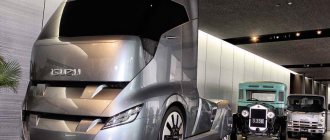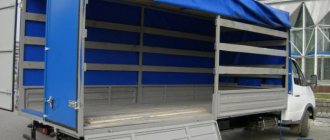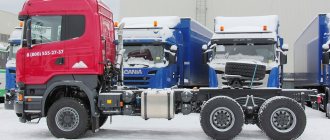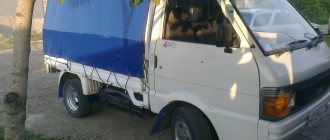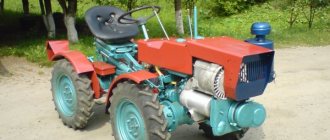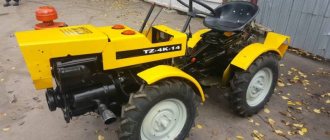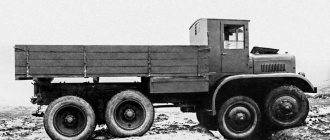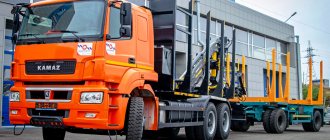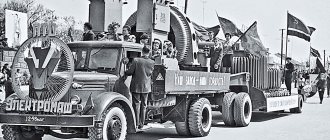Once upon a time, German
Magirus were among the top ten brands in Europe.
The company then became part of the IVECO
, and this name disappeared from the radiator grilles in 1993.
It has been preserved only on fire equipment - Magirus
has been its reputable manufacturer since 1866. But recently there was a reason to remember this well-known brand among us.
01
.
Introducing the new generation of IVECO S-Way
, the Italians also showed a certain special version of “
Magirus
”. We realized it a little late - except for the Germans, in Europe this once authoritative brand has long been forgotten. But in the territory of the former Soviet Union it is remembered very well, because it was the most popular European truck in the country. Moreover, they can still occasionally be seen in the stream.
02
.
In general, the USSR had almost all the world's famous brands of trucks. Another thing is that they were found individually, as a rule, in large cities or, conversely, far from civilization - “in the north” or in timber industry enterprises. And yet, occasionally they caught our eye, and Magirus
is no exception. This biaxial concrete mixer worked in Moscow in the seventies of the last century.
Photo from the archive of Alexander Novikov
03
.
And at a later time, the concern’s products in the USSR were closely monitored. So, in the early 1970s, NAMI underwent long-term testing of this road train with a Magirus-Deutz 230D22F
. In addition to the air diesel engine, it featured a new cabin with a panoramic windshield, as well as a “window” window in the right door, which made maneuvering easier.
04
.
Machines of this series in the USSR worked mainly in the fire department. Moreover, fire trucks of the Magirus
appeared in Russia even before the revolution, and are still being purchased. Some stairs from that series are still in service, like this example from the Belarusian Brest.
05
.
Of course, the widespread acquaintance of Soviet people with Magirus
was determined by the “contract of the century,” as the supply of almost 10,000 vehicles of this brand for the construction of BAM was called.
The most popular dump truck Magirus 290D26K
- bonneted, with an “air” diesel engine, and always orange with a red frame, is shown in the title photo. And this is the moment of their loading in the port of Hamburg onto the bulk carrier “Engineer Bashkirov”.
06
. Oh, and these cars turned out to be tenacious! Forty years later, after hard work in Siberia and several repairs, they are still found, and in the role of the same dump trucks. And they are actively selling, judging by the profile sites.
07
.
A characteristic feature of those Magiruses is the air intake pipes on the sides of the hood. This is a sign of branded engines - air-cooled diesel engines, for which, in fact, they won the contract. This still-living Surgut Magirus
is one of 1,139 flatbed trucks of the
290D26L
delivered under the same contract.
08
.
In addition to the three-axle, the same contract also included 940 two-axle dump trucks 232D19K
(232 – diesel power (D), 19 – gross weight). This surviving example, already with extended sides, was seen in Kyiv about ten years ago.
Photo by Alexander Krivchik
09
.
In addition to BAM, other cars of this brand were also purchased in batches from the USSR. The fruit of cooperation between two brands, the German Magirus
and the Finnish
Bronto
, a 33-meter lift, shown in Moscow in 1983. A whole batch of such machines was purchased by the Soviet Union.
10
.
They also turned out to be long-lived. The all-wheel drive Magirus
with an articulated lift was still operating in Georgia three years ago.
11
.
Magirus
light tow trucks appeared based on the Fiat development on the
Zeta
, but still with air-cooled diesel engines.
12
.
The fire theme remained an important part of the corporation's business. The Union continued to purchase ladder trucks of this brand, already on the new IVECO TurboTech
.
13
.
Magirus
still remains one of the key manufacturers of fire fighting equipment in the world.
And Russia continues to buy its products (the Magirus
is preserved by the fire department of the IVECO brand in its historical homeland, in the German city of Ulm).
On the left is a ladder on a special EuroFire
, on the right is a lift on an
IVECO Trakker
.
14
.
The pinnacle of Magirus' production program is this airfield monster - the all-wheel drive four-axle Magirus Super Dragon
. There is one like this in Moscow.
Photo by Dmitry Kiryushin
15
.
The people's love for the hooded Magirus was so strong that IVECO kept a similar model in its program for a long time. And when his first Russian joint venture arose with Gazprom and the Ural plant, the first model was the IVECO-Ural ANW 330-30
- an all-wheel drive analogue of the same “Bam” Magirus. Alas, it no longer had the famous “air”, and its quality was much inferior to the original.
Magirus-Deutz D290 - why Soviet drivers loved it
In the 1970s, the construction of the Baikal-Amur Mainline developed at an active pace in the Soviet Union. This construction was on a huge scale, and upon completion it was supposed to bring high profits to the country. As you know, any projects of this type require high-quality technical equipment. The Soviet Union tried with all its might to send the most powerful and heaviest trucks to the territory, but it was not easy to cope with such a task. Therefore, the government decided to purchase trucks outside the country.
Magirus-Deutz 290 has proven itself to be a reliable car
At that time, the main foreign suppliers of heavy trucks that could be used in construction were Czechoslovakia and West Germany. The first presented the Tatra manufacturer, which made a great contribution to the USSR automobile industry. In West Germany, the Magirus technique was similarly popular.
The Magirus-Deutz 290 proved to be a reliable vehicle, so within just a few months of its presence in the Soviet Union it became the leader of the liking of local drivers. We can highlight several features that ensured the model such high popularity.
The presence of an air engine cooling system saved the driver from unnecessary procedures - adding water to the radiator during frosts
First of all, drivers noted the reliability of all components and assemblies that were used in the design of this truck. In addition, he was unpretentious in terms of fuel quality. An equally important factor that played a role in shaping demand was increased cross-country ability. Some drivers noted the convenience and ease of control. The cabin provided comfort that could not be found in Soviet analogues. The popularity of the model is also evidenced by the fact that it is used even today - copies in good condition can be found on the secondary market.
A huge advantage of this truck was the power plant, which was presented in the form of a naturally-aspirated V10 diesel engine with a volume of 14.7 liters. The design was complemented by an air cooling system. The output of this unit was enough to pull even a car overloaded to 20 tons. By the way, the carrying capacity, which was indicated in the documentation, was 16 tons.
The presence of an air engine cooling system saved the driver from unnecessary procedures - adding water to the radiator during frosts. Excellent starting even in severe frost was ensured by the presence of pre-heaters. Another advantage was that the engines of this model could last up to 500,000 km without major repairs. The only thing this power unit required was high-quality oil and constant monitoring of its level. Other advantages include the cross-country ability and endurance of the chassis. The engine was paired with a six-speed gearbox without synchronizers. The rear axles had only interaxle blocking.
The cabins were thermally insulated and had triple glazing
According to drivers' reviews, the maneuverability of this vehicle reached the level of the military KrAZ-255B. But the latter was equipped with three drive axles at once. The manufacturer recommended a maximum speed of 73 km/h for this truck. But drivers noted that the car can drive on the highway at 100 km/h.
The most important thing with which the technology managed to attract the attention of Soviet drivers was a comfortable and warm cabin. All copies that were supplied to the Soviet Union were specially equipped for use in poor climatic conditions. The cabins were thermally insulated and had triple glazing. Another feature of the Soviet modification is the presence of 2 heaters at once. The devices coped with their tasks perfectly. Even with frost of 50 degrees, you could ride in the cabin in just a T-shirt. One of the heaters could warm not only the cabin, but also the battery compartment.
Bottom line . Magirus-Deutz 290 is a truck from West Germany that was delivered to the Soviet Union in the 1970s. Almost all local drivers fell in love with the transport, as it had several advantages.
Magirus, from fire wagons to trucks
Fire wagon Magirus
The Magirus company was founded in 1864 by Conrad Dietrich Magirus. Since its founding, it has been producing various fire equipment. For example, in 1870, Magirus created a revolutionary fire wagon with a 14-meter ladder. In 1910, the first fire truck left the company's workshops. And 4 years later, for the first time in the world, a rotary staircase mechanism with an electric drive appeared on them. The company also begins to produce conventional trucks and buses, on the original chassis, but using engines from other companies. This is how the first connections were made with the Humboldt-Deutz company, which was once founded by Nikolaus Otto, the inventor of the internal combustion engine.
In the early 30s, the financial crisis struck. The two manufacturers then decided to merge in 1936. Ultimately, the company was transformed into the joint stock company Klöckner Humboldt Deutz AG (KHD). Under this name the trucks went to the German army.
Supplies to the Wehrmacht
Klöckner Deutz A3000
By the beginning of the war, KHD supplied the Wehrmacht with trucks of various carrying capacities. The most massive of them is the Klöckner Deutz S3000 (330), with a lifting capacity of 3 tons. It was equipped with a 4-cylinder diesel engine with a power of 70 hp. An all-wheel drive version with a load capacity of 2.7 tons was also produced. On these trucks, the Magirus corporate logo in the form of a large letter M was replaced by a round Klöckner-Deutz badge.
In 1940, production of the Klöckner Deutz S4500 (GS145) heavy truck began. As you might guess from the index, its carrying capacity was 4.5 tons. A new 6-cylinder Deutz diesel engine with 125 hp was provided for it. All Klöckner Deutz trucks had a reputation as very reliable vehicles and were highly valued in the army. In total, KHD produced about 23 thousand trucks, which, compared to the supply of Opel Blitz, is just a drop in the bucket.
In addition to trucks, KHD was engaged in the production of half-track all-terrain vehicles Maultier (Mule). The mualtires were designated S3000 SSM and had a lifting capacity of 2 tons. Among all similar machines, the Klöckner Deutz Maultier was considered the most successful. For example, if compared with the Mualtir based on the Opel Blitz, it turns out that the KHD cars had better fuel efficiency and reliability. However, despite all their advantages, only 1,740 units were produced.

